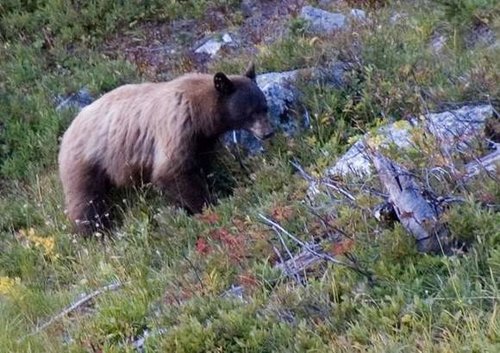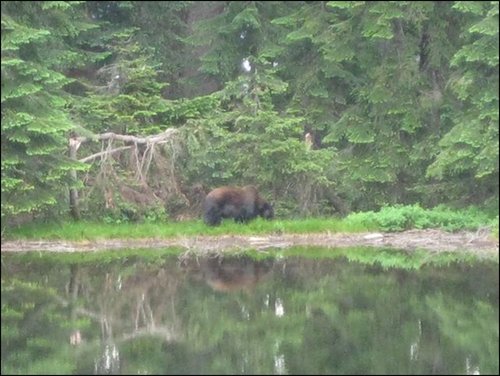rtraverdavis
Well-known member
- Joined
- Oct 20, 2016
- Messages
- 4,078
Personally, I think a few grizzlies would be pretty cool, at least in the Central Cascades of Oregon. Something’s got to cut those crowds...
Follow along with the video below to see how to install our site as a web app on your home screen.
Note: This feature may not be available in some browsers.
100% agree. My mom spent a career cruising timber on the GP and saw two wolves. But again... zero chance at a griz, despite that I've talked to tribal members that claim they released a truck load of them in the 70's.Grizzlies Around St. Helens and Adams? No. Wolves are a different story, different thread. But no griz. The closest I have been to one in my lifetime is in Montana.
100% agree. My mom spent a career cruising timber on the GP and saw two wolves. But again... zero chance at a griz, despite that I've talked to tribal members that claim they released a truck load of them in the 70's.


100% agree. My mom spent a career cruising timber on the GP and saw two wolves. But again... zero chance at a griz, despite that I've talked to tribal members that claim they released a truck load of them in the 70's.

Secretary Bernhardt Listens to Local Concerns and Scraps Plans to Reintroduce Grizzly Bears into the North Cascades Ecosystem | U.S. Department of the Interior
The Department of the Interior will not move forward with a new Grizzly Bear Restoration Plan for the North Cascades Ecosystem and the associated Environmental Impact Statement.www.doi.gov
I disagree with a couple of my friends on this. I'm playing the selfish card. I don't want grizzlies in the cascades. If they end up there naturally then so be it, but I don't support us relocating them in. Twice in the last week I thought, damn am I glad I don't have to worry about grizzlies. Once while wading through riparian brush over my head several miles into the wilderness, alone, trying to get to an off-trail, middle of nowhere lake, and the second while doing a big mt bike ride through some pretty rugged country, at dusk, again alone.
Those are black bears.I'm pretty sure this is the photo from Chiwawa River area in 2008 that they said was likely a grizzly.
View attachment 146404
Here's one from a couple years later in Snohomish Co. that got people excited but they were never able to confirm with DNA. The hump almost looks like it might be altered it's so pronounced.
View attachment 146405
Blizzly Bears?
It's bad enough we have a dozen or so wolf packs in Washington now (That nobody talks about) and the WDFW really never acknowledges. My recent spring bear hunt really kept me on edge as we ran into wolf tracks daily, spotted several groups and spoke with a local guide who talked about 3 well known packs in the Blue mountains.
WDFW never talks about the wolverines that were "introduced" into the north cascades that have now been seen on game cams all the way down into the south cascades.
On a selfish note I am with others and know that the Grizzly will and has made it's way into Washington naturally. Northwest Washington has had several sitings over the past few years so it's purely a matter of time.
i'm cool with all those but the grizz, at least in YNP densities.The wolverines have always been here. The wolves are expanding naturally and should. Grizzlies will too. We will work to manage them through hunting. They are a natural and necessary part of the system. Yes, griz do attack people on occasion, but the dangers of wolves to humans is laughable.
A 2002 report prepared for the Alaska Department of Fish and Game found no human deaths in North America attributed to wild, healthy wolves since at least 1900. Know what’s much deadlier than wolves? Domesticated dogs and cows... hahaha. Dogs kill about 30 people a year and cows about 20, and most of those are intentional attacks.
My point? Relax. Enjoy the wild. Manage all wild game through scientific study and action, including hunting. Oh, and watch out for spiders... about 7 people a year die in the US each year at the nip of the fang.
Those are black bears.

i'm cool with all those but the grizz, at least in YNP densities.
at least in YNP densities
It would mean less overall trips for me because I'd need to coordinate with a partner. Right now it's mostly solo or with the kids.That's what I think, 400 bears for the N Cascades seems like an awful lot considering the density of human population and agriculture surrounding the population. I don't lose sleep over bears or dogs or cows or spiders, or even corona virus or cancer, but I can't imagine that many grizzly in the middle of Washington not causing quite a bit of trouble, even beyond attacks.
Yes that is the best of the five photos talked about in the article.That was my thought, the first one from Chiwawa I can't figure out if it's the right one, I read in one of the articles that the photo was grainy and the bear was standing feeding from a mtn ash so not sure it's the right one. There's articles about photo confirmed sightings, but then they don't include all the photos. Here's the other one I was thinking of, from 2011. There's a photo with the article, but they don't explicitly say weather it's the photo in question or just a stock photo, and they say there were 5 photos but they only show 1. This one seems to show a dished face, shoulder hump, etc, but I'd sure like to see all 5 photos.

Rare grizzly bear photographed in North Cascades
For the first time in nearly half a century, experts have confirmed that a hiker has photographed a living grizzly bear in the North Cascades of Washington.www.seattletimes.com
Add Boulder to that mix and I will write a check to help!!!!25 each in downtown Vail and downtown Aspen ought to change the opinions of the big-money sponsors very quickly...